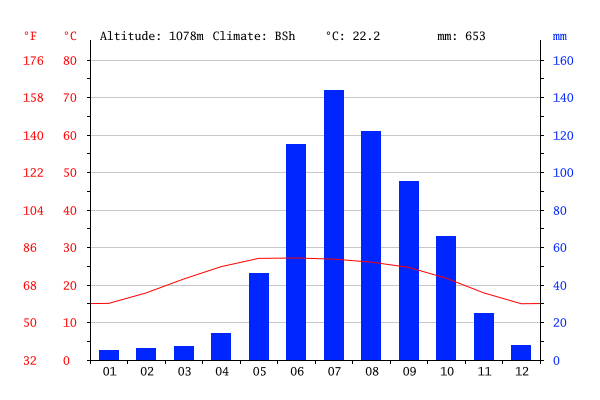
Yunnan Climate
Yunnan has a generally mild climate with pleasant and fair weather because of the province’s location on south-facing mountain slopes, receiving the influence of both the Pacific and Indian oceans, and although the growing period is long, the rugged terrain provides little arable land. Generally speaking, Yunnan enjoys a mild climate with pleasant weather but, due to its varied terrain, the weather is also diverse in different regions.
Main Features of Yunnan’s Climate
Yunnan has the subtropical monsoon climate with large daily temperature difference and clear dry and wet seasons.
1. Temperature
The average temperature, in the hottest month(July) is 19℃-22℃, in the coldest month(January) is 6℃-8℃. On the same day, it is cool in the morning and evening, but hot in noon, especially in winter and spring, daily temperature difference can reach 12℃-20℃. With long frost-free period in the whole province, the southern border is frostless all year, the frost-free period is 300-330 days in the south, 250 days in the central area, and even the relatively cold northwest Yunnan and northeast Yunnan can reach 210-220 days.
2. Precipitation
The distribution of precipitation in the whole province is extremely uneven in seasons and regions. With distinct dry and wet season, the wet season (rainy season) is May to October, 85% of rainfall concentrates upon the rainy season, and the dry season is from November to the following April, the precipitation only accounts for 15% of the whole year. The regional distribution of precipitation in the province varies greatly, with the largest annual precipitation reaching 2200-2700 mm, and the least precipitation is only 584 mm. In most parts of Yunnan, the annual precipitation is in 1000 mm above.
 Yunnan temperature and precipitation
Yunnan temperature and precipitation
3. Obvious Three-dimensional Climate
Yunnan with its complicated terrain has a varied climate. It is divided, from north to south, into three climatic zones — temperate, sub-tropical and tropical. Because of different climate distribution Yunnan from low to high terrain is also divided into over four regions- the low, hot river valleys ba zi (small upland plains), mountain areas, and frigid highlands. The climate zones and regions form a peculiar “three-dimensional” climate there.
Best Time to Visit
If you had to pick a single province in all China that would expose you to the greatest variations in topography and climate, it would have to be Yunnan Province. There is an old and accurate saying here that “You can enjoy all four seasons on the same mountain, where each of these four season is only a few miles distant from the others.
So, the best time to visit Yunnan Province depends clearly on the region you like to visit. Yunnan is a very diverse province with the Himalayas in the north and subtropics in the south. Thus, there are also specific times of the year when it’s best to visit certain destinations.
If you’d like to visit Yunnan in winter, you should prevent to go north to Shangri-La or Deqin. During this time, the Yuanyang Hani Rice Terraces or Xishuangbanna(Xishuangbanna Tropical Botanical Garden, Menglun) would be recommended to visit though. Surely, if you would like to visit Haba Snow Mountain, Meili Snow Mountain, Jade Dragon Snow Mountain and other snow mountain, winter is a good time to Visit.
Generally speaking, the weather in most areas of Yunnan is mild in winter and cool in summer. If you like, It is suitable to visit Yunnan all the year round. Attractions, such as, stone forest, Dali Ancient Town, Lijiang Ancient Town, Cangshan Mountain, Erhai Lake, Jianshui Ancient Town…are available throughout the year. Besides, in order to escape the heat in summer, Lugu Lake and Fuxian Lake are recommended then.

 7 Days GolfingTour
7 Days GolfingTour
 8 Days Group Tour
8 Days Group Tour
 8 Days Yunnan Tour
8 Days Yunnan Tour
 7 Days Shangri La Hiking
7 Days Shangri La Hiking
 11 Days Yunnan Tour
11 Days Yunnan Tour
 6 Days Yuanyang Terraces
6 Days Yuanyang Terraces
 11 Days Yunnan Tour
11 Days Yunnan Tour
 8 Days South Yunnan
8 Days South Yunnan
 7 Days Tea Tour
7 Days Tea Tour
 8 Days Muslim Tour
8 Days Muslim Tour
 12 Days Self-Driving
12 Days Self-Driving
 4 Days Haba Climbing
4 Days Haba Climbing
 Tiger Leaping Gorge
Tiger Leaping Gorge
 Stone Forest
Stone Forest
 Yunnan-Tibet
Yunnan-Tibet
 Hani Rice Terraces
Hani Rice Terraces
 Kunming
Kunming
 Lijiang
Lijiang
 Shangri-la
Shangri-la
 Dali
Dali
 XishuangBanna
XishuangBanna
 Honghe
Honghe
 Kunming
Kunming
 Lijiang
Lijiang
 Shangri-la
Shangri-la
 Yuanyang Rice Terraces
Yuanyang Rice Terraces
 Nujiang
Nujiang
 XishuangBanna
XishuangBanna
 Spring City Golf
Spring City Golf
 Snow Mountain Golf
Snow Mountain Golf
 Stone Mountain Golf
Stone Mountain Golf







